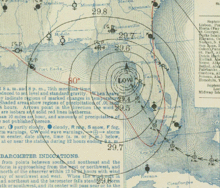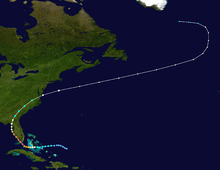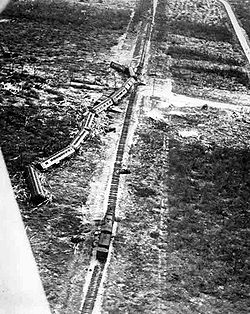
1935 Labor Day hurricane
Background Information
SOS Children made this Wikipedia selection alongside other schools resources. Before you decide about sponsoring a child, why not learn about different sponsorship charities first?
| Category 5 hurricane ( SSHS) | |
|---|---|
 |
|
| Weather Bureau surface weather map of the hurricane moving up the west coast of Florida | |
| Formed | August 29, 1935 |
| Dissipated | September 10, 1935 |
| Highest winds | 1-minute sustained: 185 mph (295 km/h) |
| Lowest pressure | 892 mbar ( hPa); 26.34 inHg |
| Fatalities | 408–600 direct |
| Damage | $6 million (1935 USD) |
| Areas affected | Bahamas, Florida Keys, Big Bend, Florida Panhandle, Georgia, South Carolina, North Carolina, Virginia |
| Part of the 1935 Atlantic hurricane season | |
The 1935 Labor Day Hurricane was the strongest tropical cyclone of the 1935 Atlantic hurricane season, and the most intense hurricane to make landfall in the United States and the Atlantic Basin in recorded history. The second tropical cyclone, second hurricane, and second major hurricane of the season, the Labor Day Hurricane was the first of three Category 5 hurricanes at landfall that the United States endured during the 20th Century (the other two being 1969's Hurricane Camille and 1992's Hurricane Andrew). After forming as a weak tropical storm east of the Bahamas on August 29, it slowly proceeded westward and became a hurricane on September 1. As Labor Day approached, hurricane warnings went up over the Keys. A train was dispatched from Miami to evacuate the Works Progress Administration (WPA) construction workers, consisting almost entirely of Bonus Army veterans and their families, from the ramshackle camps they were living in Windley Key and Lower Matecumbe Key. The train was almost entirely swept away before reaching the camps late on September 2. When it finally arrived in Upper Metecumbe Key only the engine survived the winds and wall of water that swept through the area. The hurricane struck the Upper Keys on Labor Day, Monday, September 2. The storm continued northwest along the Florida west coast, weakening before its second landfall near Cedar Key, Florida on September 4.
The compact and intense hurricane caused extreme damage in the upper Florida Keys, as a storm surge of approximately 18 to 20 feet (5.5-6 meters) swept over the low-lying islands. The hurricane's strong winds and the surge destroyed most of the buildings in the Islamorada area, and more than 200 World War I veterans housed in work camps were killed by the storm surge and flying debris. Portions of the Key West Extension of the Florida East Coast Railway were severely damaged or destroyed. The hurricane also caused additional damage in northwest Florida, Georgia, and the Carolinas. The hurricane killed more than 400 people, nearly all in the Florida Keys.
Meteorological history
The storm was born as a small tropical disturbance East of Florida near the Bahamas in late August. The disturbance moved westward toward the Gulf Stream, and US weather forecasters became aware of a potential tropical storm. The tropical storm strengthened to a Category 1 hurricane as it neared the southern tip of Andros Island in the Bahamas early on September 1.
As the hurricane passed over the warm Gulf Stream late on September 1 it underwent rapid deepening. It intensified without pause for a day and a half while its track made a gentle turn to the northwest, toward Islamorada in the Upper Keys. The hurricane reached peak intensity on September 2, making landfall between 8:30 and 9:30 p.m. EST at Craig Key.
| Most intense Atlantic hurricanes | |||||
|---|---|---|---|---|---|
| Rank | Hurricane | Season | Pressure | ||
| hPa | inHg | ||||
| 1 | Wilma | 2005 | 882 | 26.0 | |
| 2 | Gilbert | 1988 | 888 | 26.2 | |
| 3 | "Labor Day" | 1935 | 892 | 26.3 | |
| 4 | Rita | 2005 | 895 | 26.4 | |
| 5 | Allen | 1980 | 899 | 26.5 | |
| 6 | Katrina | 2005 | 902 | 26.6 | |
| 7 | Camille | 1969 | 905 | 26.7 | |
| Mitch | 1998 | 905 | 26.7 | ||
| Dean | 2007 | 905 | 26.7 | ||
| 10 | "Cuba" | 1924 | 910 | 26.9 | |
| Ivan | 2004 | 910 | 26.9 | ||
| Source: HURDAT | |||||
After striking the Keys the hurricane moved northward, weakening as it paralleled the west coast of Florida. It made a second landfall in northwest Florida near Cedar Key as a Category 2 hurricane on September 4. It quickly weakened to a tropical storm as it moved inland, passing over Georgia, South Carolina, and North Carolina before emerging into the Atlantic Ocean near Norfolk. The storm quickly re-intensified to hurricane status on September 6 as it reached winds of 90 mph (145 km/h). It quickly weakened and the system rapidly became extratropical. The remnants continued northeast until it became non-tropical south of Greenland on September 10.
Records
| Rank | Hurricane | Season | Landfall pressure |
|---|---|---|---|
| 1 | "Labor Day" | 1935 | 892 mbar ( hPa) |
| 2 | Gilbert | 1988 | 900 mbar (hPa) |
| 3 | Dean | 2007 | 905 mbar (hPa) |
| Source: National Hurricane Centre | |||
The Labor Day Hurricane was the only storm known to make landfall in the US and anywhere in the Atlantic Basin with a minimum central pressure below 900 mbar. Only 2 other hurricanes have struck the United States with winds of Category 5 strength. It remains the third-strongest Atlantic hurricane on record, surpassed only by Hurricanes Gilbert ( 1988) and Wilma (2005). However, it was the strongest for a total of 53 years, from 1935 until Gilbert formed in 1988.
The maximum sustained wind speed at landfall is estimated to have been near 185 mph (260 km/h). Recent re-analysis studies conducted by the NOAA Hurricane Research Division (HRD), suggest that the maximum sustained winds were more likely around 200 mph (295 km/h) at landfall. A landfall intensity of 200 mph makes it both the most intense land-falling hurricane and hurricane in general on record in the Western Hemisphere in terms of maximum sustained wind speed. The recorded central pressure was reported as 26.35 inHg (892 mbar hPa). This was the record low pressure for a hurricane anywhere in the Western Hemisphere until surpassed by Hurricane Gilbert in 1988 and Hurricane Wilma in 2005.
Impact
The main transportation route linking the Keys to mainland Florida was one railroad line, the Florida Overseas Railroad portion of the Florida East Coast Railway. A 10-car evacuation train, sent from Homestead, was washed off the track by the storm surge and high winds on Upper Matecumbe Key. Only the locomotive remained on the rails, and was barged back to Miami several months later. The National Weather Service estimated 408 deaths from the hurricane. Bodies were recovered as far away as Flamingo and Cape Sable on the southwest tip of the Florida mainland.
| Rank | Hurricane | Season | Landfall pressure |
|---|---|---|---|
| 1 | "Labor Day" | 1935 | 892 mbar ( hPa) |
| 2 | Camille | 1969 | 909 mbar (hPa) |
| 3 | Katrina | 2005 | 920 mbar (hPa) |
| 4 | Andrew | 1992 | 922 mbar (hPa) |
| 5 | "Indianola" | 1886 | 925 mbar (hPa) |
| 6 | "Florida Keys" | 1919 | 927 mbar (hPa) |
| 7 | "Okeechobee" | 1928 | 929 mbar (hPa) |
| 8 | "Great Miami" | 1926 | 930 mbar (hPa) |
| Donna | 1960 | 930 mbar (hPa) | |
| 10 | Carla | 1961 | 931 mbar (hPa) |
| Source: HURDAT, Hurricane Research Division |
|||
The hurricane left a path of near destruction in the Upper Keys, centered on what is today the village of Islamorada. Nearly every structure was demolished, and some bridges and railway embankments were washed away. The links — rail, road, and ferry boats — that chained the islands together were broken. The Islamorada area was devastated, although the hurricane's destructive path was narrower than most tropical cyclones. Its eye was eight miles (13 km.) across and the fiercest winds extended 15 miles (24 km.) off the centre, less than 1992's Hurricane Andrew, which was also a relatively small and catastrophic Category 5 hurricane.
Craig Key, Long Key, and Upper Matecumbe and Lower Matecumbe Keys suffered the worst. After the third day of the storm corpses swelled and split open in the subtropical heat, according to rescue workers. Public health officials ordered plain wood coffins holding the dead to be stacked and burned in several locations.
The United States Coast Guard and other state and federal agencies organized evacuation and relief efforts. Boats and airplanes carried injured survivors to Miami. The railroad was never rebuilt, but temporary bridges and ferry landings were under construction as soon as materials arrived. Within a few years a roadway ( Overseas Highway) linked the Keys to the mainland. The storm caused wind and flood damage along the Florida panhandle and into Georgia.
Ernest Hemingway visited the veteran's camp by boat after weathering the hurricane at his home in Key West; he wrote about the devastation in a critical article titled Who Killed the Vet for The New Masses magazine. Hemingway implied that the WPA workers and families, who were unfamiliar with the risks of Florida hurricane season, were unwitting victims of an system that appeared to lack concern for their welfare. From the Ernest Hemingway statement on the tragedy:
...wealthy people, yachtsmen, fishermen such as President Hoover and Presidents Roosevelt, do not come to the Florida Keys in hurricane months.... There is a known danger to property. But veterans, especially the bonus-marching variety of veterans, are not property. They are only human beings; unsuccessful human beings, and all they have to lose is their lives. They are doing coolie labor for a top wage of $45 a month and they have been put down on the Florida Keys where they can't make trouble. It is hurricane months, sure, but if anything comes up, you can always evacuate them, can't you?.....It is not necessary to go into the deaths of the civilians and their families since they were on the Keys of their own free will; They made their living there, had property and knew the hazards involved. But the veterans had been sent there; they had no opportunity to leave, nor any protection against hurricanes; and they never had a chance for their lives. Who sent nearly a thousand war veterans, many of them husky, hard-working and simply out of luck, but many of them close to the border of pathological cases, to live in frame shacks on the Florida Keys in hurricane months?
As curiosity, eccentric inventor Donald Roebling was impressed by the difficulties in rescuing victims of this hurricane, and that inspired him to design an amphibious tractor that could travel through flooded areas. Such a vehicle evolved into the Landing Vehicle Tracked (LVT) series of amphibious tractors and amphibious personnel carriers, widely used during WW2.
Memorial
|
Florida Keys Memorial
|
|
|
U.S. National Register of Historic Places
|
|
 |
|
|
|
|
| Location: | Mile marker 82, Islamorada, Florida |
|---|---|
| Coordinates: | 24°55′N 80°38′W Coordinates: 24°55′N 80°38′W |
| Built: | 1937 |
| Governing body: | Private |
| NRHP Reference#: | 95000238 |
| Added to NRHP: | March 16, 1995 |
Standing just east of U.S. 1 at mile marker 82 in Islamorada, near where Islamorada's post office stood, is a simple monument designed by the Florida Division of the Federal Art Project and constructed using Keys limestone (" keystone") by the Works Progress Administration. It was unveiled in 1937 with more than 4,000 people attending. A frieze depicts palm trees amid curling waves, fronds bent in the wind. In front of the sculpture a ceramic- tile mural of the Keys covers a stone crypt, which holds victims' ashes from the makeshift funeral pyres. The memorial was added to the U.S. National Register of Historic Places on March 16, 1995.
The text on a plaque entitled "The Florida Keys Memorial" in front of the monument reads:
The Florida Keys Memorial, known locally as the "Hurricane Monument," was built to honour hundreds of American veterans and local citizens who perished in the "Great Hurricane" on Labor Day, September 2, 1935. Islamorada sustained winds of 200 miles per hour (322 kph) and a barometer reading of 26.36 inches (66.95 cm) for many hours on that fateful holiday; most local buildings and the Florida East Coast Railway were destroyed by what remains the most savage hurricane on record. Hundreds of WWI veterans who had been camped in the Matecumbe area while working on the construction of US Highway One for the Works Progress Administration (WPA) were killed. In 1937 the cremated remains of approximately 300 people were placed within the tiled crypt in front of the monument. The monument is composed of native keystone, and its striking frieze depicts coconut palm trees bending before the force of hurricane winds while the waters from an angry sea lap at the bottom of their trunks. Monument construction was funded by the WPA and regional veterans' associations. Over the years the Hurricane Monument has been cared for by local veterans, hurricane survivors, and descendants of the victims.
Local residents hold ceremonies at the monument every year on Labor Day (on the Monday holiday) and on Memorial Day to honour the veterans and the civilians who died in the hurricane.
Key Largo
In the 1948 Warner Brothers film, Key Largo, Lionel Barrymore recalled the effects of the 1935 hurricane, as another hurricane bore down on the Florida Keys. Special effects were used on the Warner lot in the film to re-create a powerful hurricane.
Audio Recording
- Audio recording of a song titled "Storm of the Century"
- lyrics of song titled "Storm of the Century"



